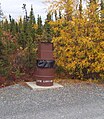Trash can
A trash can , Swiss and rubbish bin in Austria dustbin , is a container for the collection and storage of waste until it finally disposed of are. In contrast to the garbage can , rubbish bin or trash can is the usual name for a small container, mostly inside the apartment, or as street furniture outdoors. Trash cans are usually made of plastic , sheet metal or wire . The wastepaper basket is a special form .
Municipal waste bins
In many cities and municipalities, the waste is collected in separate waste bins so that waste can be sorted before it is disposed of in the municipalities . In addition to the garbage cans for residual waste , there are also those for organic waste , paper collection, glass collection (separated into white and stained glass), as well as bins for plastic, metal and other types of waste.
history
Systems
At the beginning of the 20th century, the big cities experimented with special containers for waste disposal. In French, the word poubelle became the term for rubbish bin, after the Prefect Eugène Poubelle . The Ochsner waste bins were introduced in Switzerland from 1902 . After the city of Cologne had already introduced a system for waste disposal with metal buckets and disposal vehicles trained for their easy emptying, the Viennese city administration took over this "Colonia" system, which, like the Swiss "Ochsner", was designed as a collection system through the use of apartment containers. and further developed it for the Viennese city cleaning service, since "despite all the regulations [...] the house parties could not be induced to take the containers onto the street shortly before the arrival of the collective train and to clear them away again immediately after they were emptied". Therefore, “the population and the company had to be made independent of one another”.
Historical colony buckets from Vienna
The Viennese city administration under Franz Siegel , following the example of Cologne from 1918, after the end of the First World War , instead of collecting garbage by horse-drawn vehicles on certain dates, the installation of uniform, almost dust-free metal waste containers with lids, the colonia buckets, a. The metal buckets with tilting lids, which were introduced across the board until 1928, had a capacity of 90 liters and were hung on the wall in inner courtyards or in the hallway. From there they had to be picked up by the garbage disposal for waste disposal. Waste disposal was free until 1934.
This takeover of the Colonia system based on the Cologne model led to the historical name Koloniakübel in Vienna , also known as Coloniakübel or Colonia-Kübel. Accordingly, the room in the entrance area was called the Colonia room and the disposal vehicle was called the Colonia car.
At the beginning of the 1960s, the round buckets were enlarged and later supplemented by large, rectangular rubbish bins , also made of sheet metal. From the mid-1970s, both system vessels were replaced by plastic buckets or barrels.
New systems for waste bins
Solar-powered rubbish bins with an integrated garbage compactor, which can collect a multiple of the amount of waste and pass on their fill level via an Internet connection, have been in use in the United States and occasionally in Germany since 2004. In 2014, around 250 spacious and vandal-proof waste bins with integrated photovoltaics were installed in Switzerland . Birds, cats, rats and other nocturnal interested parties can no longer get to the waste with such containers, which makes city cleaning easier.
In some municipalities, especially in the old town, tourism or city area, attempts are being made to master the growing amount of waste and vandalism with the underfloor solution. The main advantage of this complex solution is not only the clean appearance, but also the space savings and the integrated fire protection. These underground waste bins can also be emptied with the usual municipal road sweepers with a vacuum cleaner .
Special waste bins
Especially in hospitals or in companies with dangerous goods there are special systems of rubbish bins that can be closed after a single use and cannot be opened again. Hazardous materials or infectious waste, for example, are disposed of in such bins. Depending on their content, these rubbish bins can then be burned or safely stored in special facilities.
There are also a large number of rubbish bins in special designs, some of which are art projects, guerrilla marketing campaigns or simply custom-made items.
Garbage can in the household
The waste is sometimes already collected in separate waste bins in order to facilitate the subsequent separation of waste into the appropriate waste bins. There are also buckets with separate compartments for organic waste and glass.
Pedal bin
Under a pedal bin is meant a waste bin provided with a lid is closed and by pressing a pedal opens. Pressing the pedal moves a rod construction that ends at the lid of the pedal bin. In everyday life, pedal bins are often used in kitchens and bathrooms to keep the garbage can closed and to make hand contact with the container unnecessary.
Many pedal bins are made of stainless steel on the outside so that they do not corrode from the splashing water . The pole structure is attached to the floor and walls. A plastic insert is placed over it, which rests on the edge. Since the insert is removed, the waste is either disposed of directly into the application or from hygiene reasons in a loaded trash bag .
Gallery of rubbish bins in different shapes
A trash can attached to a public transport stop
Dustbin next to the Shelbourne Hotel in Dublin
Waste container of the Deutsche Bahn AG
Trash can in Malinska-Dubašnica on the beach
A trash can in Taiwan
Trash can in Saint Petersburg
Painted rubbish bin in Uetersen
Underground containers for sorting waste in the old town of Písek in the Czech Republic
Emptying a large-volume underground collection container in Prague
A bear-safe trash can in Lake Louise State Park , Alaska
Trash can in Berlin with a funny saying
Trash can in Berlin
See also
- Waste disposal
- recycling
- Littering (litter)
Web links
Individual evidence
- ↑ a b Coloniakübel, Koloniakübel, der. In: Duden online, without date, accessed on September 17, 2018: The Duden recommends the spelling “Coloniakübel” and explains the origin of the word: “To Latin Colonia Agrippinensis = Cologne (since Vienna has adopted the new system of garbage disposal in tubs from Cologne has been)".
- ↑ a b c Web editorial office of MA 48: History of the Viennese garbage disposal. In: Stadt Wien (wien.gv.at), Magistrat der Stadt Wien (publisher), undated, accessed on September 17, 2018.
- ^ Gregor Gatscher-Riedl: Waste disposal free of charge until 1934. In: NÖN , week 30/2015.
- ^ Robert Sedlaczek: The Austrian German. Vienna, 2004, ISBN 3-8000-7075-8 , p. 251.
- ↑ 'Big Belly' Arrives, Ready To Eat Trash - Or at Least Crush It. In: The New York Sun . March 2, 2005, accessed September 16, 2012 .
- ↑ Steeled in the Bronx. In: Frankfurter Rundschau . October 7, 2010, accessed September 16, 2012 .
- ↑ Garbage cans with internet connection. In: gulli.com . September 9, 2012, accessed September 16, 2012 .
- ↑ Speaking and pressing. In: Thurgauer Zeitung , February 14, 2014.
- ↑ Martin Röhl: Garbage in the underground. Idea for the city of tomorrow. ( Memento of September 17, 2018 in the Internet Archive ) In: nexthamburg, May 6, 2009, Nexthamburg eV (Ed.), Accessed on September 17, 2018.






















